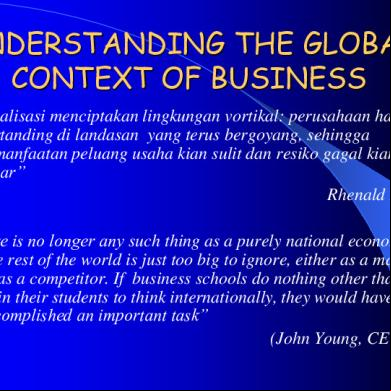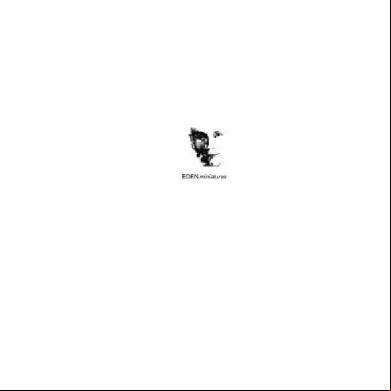Global Dimensions 6u2a2m
This document was ed by and they confirmed that they have the permission to share it. If you are author or own the copyright of this book, please report to us by using this report form. Report 3i3n4
Overview 26281t
& View Global Dimensions as PDF for free.
More details 6y5l6z
- Words: 1,194
- Pages: 31
UNDERSTANDING THE GLOBAL CONTEXT OF BUSINESS “Globalisasi menciptakan lingkungan vortikal: perusahaan harus
bertanding di landasan yang terus bergoyang, sehingga pemanfaatan peluang usaha kian sulit dan resiko gagal kian besar” Rhenald Kasali “There is no longer any such thing as a purely national economy. The rest of the world is just too big to ignore, either as a market or as a competitor. If business schools do nothing other than to train their students to think internationally, they would have accomplished an important task” (John Young, CEO HP)
THE RISE OF INTERNATIONAL BUSINESS
GLOBAL ECONOMY: resource supplies, product markets, & business competition are worldwide rather than purely local or national scope GLOBALIZATION: – Is the process of growing interdependence among elements of the global economy – Process by which the world economy is becoming a single interdependent system KEY WORD: GLOBALIZATION, IMPORT, EXPORT
The
Contemporary Global Economy
– WTO
The
ADOPT FAIR TRADE POLICIES & PRACTICES REDUCE TRADE BARRIERS BY PROMOTING MULTILATERAL NEGOTIATIONS AMONG MEMBER NATIONS ESTABLISH FAIR PROCEDURES FOR RESOLVING DISPUTES AMONG MEMBER NATIONS
Major World Marketplaces
– HIGH-INCOME COUNTRIES (> $9,386) – MIDDLE-INCOME COUNTRIES ($9,386 – 765) – LOW-INCOME COUNTRIES (< $765)
THE
AMERICAS
NAFTA: is the North American Free Trade Agreement linking Canada, the US, & Mexico in a regional economic alliance Maquiladoras: foreign manufacturing plants that operate in Mexico with special privileges
– DaimlerChrysler, GM, VW, Nissan & Ford – 1993 – 1999: export increased from $7.2 bill to
$20.4 billion, employs 380,000 workers, growth rate 10& by 2001.
The North American Marketplace
EUROPE:
15 countries (in the near future 25 ) The Euro: is the new common European currency Access to market 375 million consumers
– Unilever, Renault, Royal Dutch/ Shell,
Siemens, Nestle
Europe and the Nations of the European Union
ASIA
& THE PACIFIC RIM
Japan, China, Thailand, Malaysia, Singapore, Indonesia, South Korea, Taiwan, the Philippines & Australia. Emerging world-class competitors from Asian countries: Toyota, Toshiba, Samsung & Hyundai APEC (Asia-Pacific Economic Coop.)
The Nations of ASEAN
FORM
OF COMPETITIVE ADVANTAGE
Absolute Advantage Comparative Advantage National Competitive Advantage
– Factors of production – Demand conditions – Related & ing industries
– Strategies, structures & rivalries
NATIONAL DIAMOND
IMPORT-EXPORT
BALANCES
Balance of trade – Deficit or surplus
Balance of payments – Inflows & outflows – Exchange rate – Exchange rate & competition
INTERNATIONAL BUSINESS MANAGEMENT
GOING INTERNATIONAL AN INTERNATIONAL BUSINESS CONDUCTS COMMERCIAL TRANSACTIONS ACROSS NATIONAL BOUNDARIES – – – – –
PROFIT CUSTOMERS SUPPLIERS CAPITAL LABOURS
ADAPTING TO CUSTOMER NEEDS???
Going International
INTERNATIONAL BUSINESS CHALLENGES
AN INTERNATIONAL BUSINESS CONDUCTS COMMERCIAL TRANSACTIONS ACROSS NATIONAL BOUNDARIES – PROFIT
– CUSTOMERS – SUPPLIERS – CAPITAL – LABOURS
Maximising the return on competitive advantages
RESOURCE AVAILABILITY IN THE ASIAN REGION
Resource Competence Raw Materials Components Labour
Components Logistics Flexibility Market Info & Linkages New Materials New Processes
Countries Indonesia China Philippines Thailand Malaysia Korea Taiwan Singapore Hong Kong
Japan
Source of Advantage Sourcing Costs
Sourcing Cost Market Adaptation Service Technology
Achieving locational economies – ex: American buys a pontiac le mans from general motors
- $10,000 (this reflects the following international transactions) $3000 to South Korea for routine labor & assembly operations $1750 to Japan for advanced components - engine, transaxles, electronic $750 to for styling and design engineering) $400 to Taiwan, Singapore & Japan for small components $250 to Britain for advertising & marketing services $50 to Ireland & Barbados for data processing The balance some $4000 is distributed primarily within the US.
FORMS OF INTERNATIONAL BUSINESS
STRATEGY Market entry Global Exporting Licensing & sourcing Importing Franchising
Direct investment t Ventures Wholly owned subsidiaries
LEVEL OF INVOLVEMENT – EXPORTERS & IMPORTERS – INTERNATIONAL FIRMS – MULTINATIONAL FIRMS
INTERNATIONAL ORG’L STRUCTURES – INDEPENDENT AGENTS – LICENSING ARRANGEMENTS – BRANCH OFFICES
– STRATEGIC ALLIANCES
– FOREIGN DIRECT INVESTMENT
Expanding growth in the exchange of information & trade in services. Ex: Montague Corp - designs a unique product (folding mountain bikes) in Cambridge, manufacturers in Taiwan, sells in Europe.
COMPARISON OF INTERNATIONAL-TRADE, COUNTRY-FOCUSED, & GLOBALLY INTEGRATED DESIGNS INTERNATIONAL TRADE DESIGNS
STRAT.FOCUS Standardised product
GLOBALLY INTEGRATED DESIGNS
COUNTRYFOCUSED DESIGNS
Global products Products developed for export adjusted for for specific local market local differences STRAT.RESP’TY Centralised headquarter Shared among global Decentralized to the div. Headquarters & div. SUBUNIT REL. Hierarchical Interdependent Semiautonomous DISTRIBUTION Located in home country Dispersed through- Located in each div OF CRIT.FUNC. out the div.network EXAMPLE: Toyota (1970s) Toyota (1980s) GM (1980) GM (1970s)
GLOBALLY INTEGRATED DESIGN: creates an interdependent network
Country G Division
Country F Division
Country E Division
Country A Division
Country B Division
Global
Country C Division
Headquarters Country D Division
MULTINATIONAL CORPORATIONS
AN MNC: IS A BUSINESS WITH EXTENSIVE INTERNATIONAL OPERATIONS IN MORE THAN ONE FOREIGN COUNTRY – GE, Exxon, Wal Mart, Mitsubishi, etc
TYPES OF MNC – TRANSNATIONAL CORPORATIONS – PROS & CONS OF MNC
MULTINATIONAL CORPORATIONS MNC-HOST COUNTRY RELATIONSHIPS WHAT SHOULD GO RIGHT: MUTUAL BENEFITS
– SHARED OPPORTUNITIES WITH
POTENTIAL FOR GROWTH, INCOME, LEARNING, DEVELOPMENT
MULTINATIONAL CORPORATIONS
MNC-HOST COUNTRY RELATIONSHIPS WHAT CAN GO WRONG HOST-COUNTRY COMPLAINT ABOUT MNCs – EXCESSIVE PROFITS
– ECONOMIC DOMINATION – INTERFERENCE WITH GOV. – HIRE BEST LOCAL TALENT
– LIMITED TECHNOLOGY TRANSFER – DISRESPECT FOR LOCAL CUSTOMS
MULTINATIONAL CORPORATIONS
MNC-HOST COUNTRY RELATIONSHIPS WHAT CAN GO WRONG MNC COMPLAINTS ABOUT HOST COUNTRIES – PROFITS LIMITATIONS
– OVERPRICED RESOURCES – EXPLOITATIVE RULES – FOREIGN EXCHANGE RESTRICTIONS
– FAILURE TO UPHOLD CONTRACTS
MULTINATIONAL CORPORATIONS
ETHICAL ISSUES FOR MNC OPERATIONS – CORRUPTIONS – SWEATSHOPS – CHILD LABOR
– SUSTAINABLE DEVELOPMENT – ISO 14000
BARRIERS TO INTERNATIONAL TRADE
SOCIAL & CULTURAL DIFFERENCES CULTURE SHOCK POPULAR DIMENSIONS OF CULTURE – LANGUAGE
– INTERPERSONAL SPACE – TIME ORIENTATION: Monochronic or Polychronic – RELIGION
– ROLE OF AGREEMENTS
VALUES & NATIONAL CULTURES
BARRIERS TO INTERNATIONAL TRADE ECONOMIC DIFFERENCES LEGAL & POLITICAL DIFFERENCES
– Quotas ( Or Embargo), Tarrifs & Subsidies – Local Content Laws: Cartel
Adjusting to Local Differences: The Coca-Cola Company Thinking Globally & Managing Locally (Morden)
PRODUCT: COCA COLA PRODUCES & MARKETS THE COKE, FANTA, & SPRITE BRANDS GLOBALLY BUT OTHER PRODUCTS ARE TAILORED TO A SPECIFIC COUNTRY/ TO A SPECIFIC GEOGRAPHY – IN BRAZIL - GUARANA TAI, NORTHERN LATIN AMERICA (ELSAVADOR & VENEZUELA) - FANTAKOLITA (A CREAM SODA TYPE OF DRINK). – IN - A TART ORANGE TASTE IS PREFERRED – IN ITALY - SWEET
MARKETING: COKE REENTERED CHINA IN 1979, LITERAL REPRESENTATION OF ITS NAME IN CHINESE CHARACTERS WAS “A BITE THE WAX TADPOLE”, LAUNCHED & AD CAMPAIGN IN ASIAN MARKET BASED ON A “COME A LIVE” THEME - TRANSLATED AS “THIS PRODUCT MAKES YOUR ANCESTORS RISE FROM THE DEAD” DISTRIBUTION: VENDING MACHINES, SMALL PLACTICS COOLERS ETC
Thinking Globally & Managing Locally (Morden) Managing locally: – Knowledge of country & its international context
– Knowledge of communication patterns – Knowledge of country’s culture – Control & co-ordination – Commitment
bertanding di landasan yang terus bergoyang, sehingga pemanfaatan peluang usaha kian sulit dan resiko gagal kian besar” Rhenald Kasali “There is no longer any such thing as a purely national economy. The rest of the world is just too big to ignore, either as a market or as a competitor. If business schools do nothing other than to train their students to think internationally, they would have accomplished an important task” (John Young, CEO HP)
THE RISE OF INTERNATIONAL BUSINESS
GLOBAL ECONOMY: resource supplies, product markets, & business competition are worldwide rather than purely local or national scope GLOBALIZATION: – Is the process of growing interdependence among elements of the global economy – Process by which the world economy is becoming a single interdependent system KEY WORD: GLOBALIZATION, IMPORT, EXPORT
The
Contemporary Global Economy
– WTO
The
ADOPT FAIR TRADE POLICIES & PRACTICES REDUCE TRADE BARRIERS BY PROMOTING MULTILATERAL NEGOTIATIONS AMONG MEMBER NATIONS ESTABLISH FAIR PROCEDURES FOR RESOLVING DISPUTES AMONG MEMBER NATIONS
Major World Marketplaces
– HIGH-INCOME COUNTRIES (> $9,386) – MIDDLE-INCOME COUNTRIES ($9,386 – 765) – LOW-INCOME COUNTRIES (< $765)
THE
AMERICAS
NAFTA: is the North American Free Trade Agreement linking Canada, the US, & Mexico in a regional economic alliance Maquiladoras: foreign manufacturing plants that operate in Mexico with special privileges
– DaimlerChrysler, GM, VW, Nissan & Ford – 1993 – 1999: export increased from $7.2 bill to
$20.4 billion, employs 380,000 workers, growth rate 10& by 2001.
The North American Marketplace
EUROPE:
15 countries (in the near future 25 ) The Euro: is the new common European currency Access to market 375 million consumers
– Unilever, Renault, Royal Dutch/ Shell,
Siemens, Nestle
Europe and the Nations of the European Union
ASIA
& THE PACIFIC RIM
Japan, China, Thailand, Malaysia, Singapore, Indonesia, South Korea, Taiwan, the Philippines & Australia. Emerging world-class competitors from Asian countries: Toyota, Toshiba, Samsung & Hyundai APEC (Asia-Pacific Economic Coop.)
The Nations of ASEAN
FORM
OF COMPETITIVE ADVANTAGE
Absolute Advantage Comparative Advantage National Competitive Advantage
– Factors of production – Demand conditions – Related & ing industries
– Strategies, structures & rivalries
NATIONAL DIAMOND
IMPORT-EXPORT
BALANCES
Balance of trade – Deficit or surplus
Balance of payments – Inflows & outflows – Exchange rate – Exchange rate & competition
INTERNATIONAL BUSINESS MANAGEMENT
GOING INTERNATIONAL AN INTERNATIONAL BUSINESS CONDUCTS COMMERCIAL TRANSACTIONS ACROSS NATIONAL BOUNDARIES – – – – –
PROFIT CUSTOMERS SUPPLIERS CAPITAL LABOURS
ADAPTING TO CUSTOMER NEEDS???
Going International
INTERNATIONAL BUSINESS CHALLENGES
AN INTERNATIONAL BUSINESS CONDUCTS COMMERCIAL TRANSACTIONS ACROSS NATIONAL BOUNDARIES – PROFIT
– CUSTOMERS – SUPPLIERS – CAPITAL – LABOURS
Maximising the return on competitive advantages
RESOURCE AVAILABILITY IN THE ASIAN REGION
Resource Competence Raw Materials Components Labour
Components Logistics Flexibility Market Info & Linkages New Materials New Processes
Countries Indonesia China Philippines Thailand Malaysia Korea Taiwan Singapore Hong Kong
Japan
Source of Advantage Sourcing Costs
Sourcing Cost Market Adaptation Service Technology
Achieving locational economies – ex: American buys a pontiac le mans from general motors
- $10,000 (this reflects the following international transactions) $3000 to South Korea for routine labor & assembly operations $1750 to Japan for advanced components - engine, transaxles, electronic $750 to for styling and design engineering) $400 to Taiwan, Singapore & Japan for small components $250 to Britain for advertising & marketing services $50 to Ireland & Barbados for data processing The balance some $4000 is distributed primarily within the US.
FORMS OF INTERNATIONAL BUSINESS
STRATEGY Market entry Global Exporting Licensing & sourcing Importing Franchising
Direct investment t Ventures Wholly owned subsidiaries
LEVEL OF INVOLVEMENT – EXPORTERS & IMPORTERS – INTERNATIONAL FIRMS – MULTINATIONAL FIRMS
INTERNATIONAL ORG’L STRUCTURES – INDEPENDENT AGENTS – LICENSING ARRANGEMENTS – BRANCH OFFICES
– STRATEGIC ALLIANCES
– FOREIGN DIRECT INVESTMENT
Expanding growth in the exchange of information & trade in services. Ex: Montague Corp - designs a unique product (folding mountain bikes) in Cambridge, manufacturers in Taiwan, sells in Europe.
COMPARISON OF INTERNATIONAL-TRADE, COUNTRY-FOCUSED, & GLOBALLY INTEGRATED DESIGNS INTERNATIONAL TRADE DESIGNS
STRAT.FOCUS Standardised product
GLOBALLY INTEGRATED DESIGNS
COUNTRYFOCUSED DESIGNS
Global products Products developed for export adjusted for for specific local market local differences STRAT.RESP’TY Centralised headquarter Shared among global Decentralized to the div. Headquarters & div. SUBUNIT REL. Hierarchical Interdependent Semiautonomous DISTRIBUTION Located in home country Dispersed through- Located in each div OF CRIT.FUNC. out the div.network EXAMPLE: Toyota (1970s) Toyota (1980s) GM (1980) GM (1970s)
GLOBALLY INTEGRATED DESIGN: creates an interdependent network
Country G Division
Country F Division
Country E Division
Country A Division
Country B Division
Global
Country C Division
Headquarters Country D Division
MULTINATIONAL CORPORATIONS
AN MNC: IS A BUSINESS WITH EXTENSIVE INTERNATIONAL OPERATIONS IN MORE THAN ONE FOREIGN COUNTRY – GE, Exxon, Wal Mart, Mitsubishi, etc
TYPES OF MNC – TRANSNATIONAL CORPORATIONS – PROS & CONS OF MNC
MULTINATIONAL CORPORATIONS MNC-HOST COUNTRY RELATIONSHIPS WHAT SHOULD GO RIGHT: MUTUAL BENEFITS
– SHARED OPPORTUNITIES WITH
POTENTIAL FOR GROWTH, INCOME, LEARNING, DEVELOPMENT
MULTINATIONAL CORPORATIONS
MNC-HOST COUNTRY RELATIONSHIPS WHAT CAN GO WRONG HOST-COUNTRY COMPLAINT ABOUT MNCs – EXCESSIVE PROFITS
– ECONOMIC DOMINATION – INTERFERENCE WITH GOV. – HIRE BEST LOCAL TALENT
– LIMITED TECHNOLOGY TRANSFER – DISRESPECT FOR LOCAL CUSTOMS
MULTINATIONAL CORPORATIONS
MNC-HOST COUNTRY RELATIONSHIPS WHAT CAN GO WRONG MNC COMPLAINTS ABOUT HOST COUNTRIES – PROFITS LIMITATIONS
– OVERPRICED RESOURCES – EXPLOITATIVE RULES – FOREIGN EXCHANGE RESTRICTIONS
– FAILURE TO UPHOLD CONTRACTS
MULTINATIONAL CORPORATIONS
ETHICAL ISSUES FOR MNC OPERATIONS – CORRUPTIONS – SWEATSHOPS – CHILD LABOR
– SUSTAINABLE DEVELOPMENT – ISO 14000
BARRIERS TO INTERNATIONAL TRADE
SOCIAL & CULTURAL DIFFERENCES CULTURE SHOCK POPULAR DIMENSIONS OF CULTURE – LANGUAGE
– INTERPERSONAL SPACE – TIME ORIENTATION: Monochronic or Polychronic – RELIGION
– ROLE OF AGREEMENTS
VALUES & NATIONAL CULTURES
BARRIERS TO INTERNATIONAL TRADE ECONOMIC DIFFERENCES LEGAL & POLITICAL DIFFERENCES
– Quotas ( Or Embargo), Tarrifs & Subsidies – Local Content Laws: Cartel
Adjusting to Local Differences: The Coca-Cola Company Thinking Globally & Managing Locally (Morden)
PRODUCT: COCA COLA PRODUCES & MARKETS THE COKE, FANTA, & SPRITE BRANDS GLOBALLY BUT OTHER PRODUCTS ARE TAILORED TO A SPECIFIC COUNTRY/ TO A SPECIFIC GEOGRAPHY – IN BRAZIL - GUARANA TAI, NORTHERN LATIN AMERICA (ELSAVADOR & VENEZUELA) - FANTAKOLITA (A CREAM SODA TYPE OF DRINK). – IN - A TART ORANGE TASTE IS PREFERRED – IN ITALY - SWEET
MARKETING: COKE REENTERED CHINA IN 1979, LITERAL REPRESENTATION OF ITS NAME IN CHINESE CHARACTERS WAS “A BITE THE WAX TADPOLE”, LAUNCHED & AD CAMPAIGN IN ASIAN MARKET BASED ON A “COME A LIVE” THEME - TRANSLATED AS “THIS PRODUCT MAKES YOUR ANCESTORS RISE FROM THE DEAD” DISTRIBUTION: VENDING MACHINES, SMALL PLACTICS COOLERS ETC
Thinking Globally & Managing Locally (Morden) Managing locally: – Knowledge of country & its international context
– Knowledge of communication patterns – Knowledge of country’s culture – Control & co-ordination – Commitment










